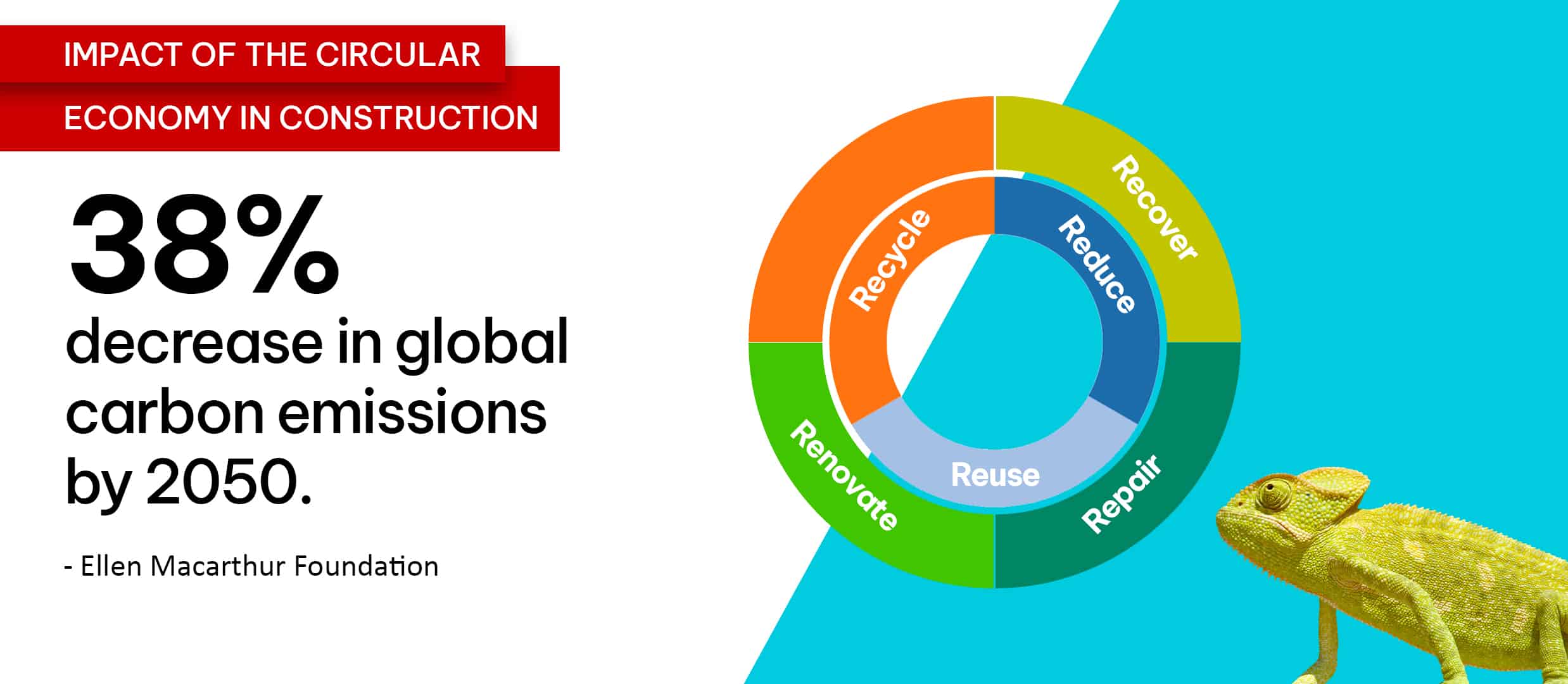How to Achieve The Circular Economy in Office Design
What is the Circular Economy?
The Circular Economy in Office Design is a key concept driving sustainability in modern workplaces. It aims to keep products, materials, and resources in use for as long as possible, dramatically reducing environmental impact and waste.
Traditionally, office construction and interiors follow a “linear economy” model: raw materials are extracted, used once, and then discarded. This contributes heavily to carbon emissions, resource depletion, and landfill waste. A circular economy model transforms this by designing offices that regenerate, adapt, and extend the life of resources through smart planning, reuse, and recycling.
This approach makes the most of the available material resources, extending the product life cycle. The idea arises from imitating nature, where waste becomes a new resource. The 3Rs of sustainable development are Reduce, Reuse and Recycle, these principles minimise the impact, saving resources and energy. There are four new in the chain: Repair, Renovate, Recycle and Recover. The Circular Economy in Office Design reduces emissions, waste, and the consumption of natural resources.
Principles of Circular Office Design
- Design for Disassembly: Products and interiors should be easy to dismantle, relocate, or reuse.
- Material Transparency: Choosing certified sustainable materials (like Cradle to Cradle Certified™ products).
- Flexible Layouts: Office layouts that can evolve with changing business needs, reducing the need for frequent demolitions.
- Modular Furniture Systems: Movable and adaptable furniture promotes longevity and reuse.
- Asset Tracking: Maintaining an inventory (materials passport) for easier future reuse or recycling.
What is The Circular Office
The Circular Economy in Office Design is starting to be effectively applied to office design. The most valuable characteristic of circular office design is the recycling of raw materials. Instead of getting rid of products that are (partly) good, everything will be reused.
Circular design offers flexibility and a wide range of options to meet design needs. It embraces reconfigurable elements like modular seating, mobile meeting pods, and smart storage systems that support both present-day and future workspace requirements. The circular office ensures the efficient use of resources such as water and energy and implements paperless offices.
However, to create a circular office, it is essential to maximise energy efficiency and the utilisation of resources. It also needs the effective use of space, aligned with the evolving, flexible, and collaborative office environments.
Furthermore, the office must be an adaptable workplace that provides sufficient support to present the activity. It also has to be capable of adapting to future uses. Demountable and adaptable design can provide both sustainable and more engaging office spaces.
It’s estimated that a circular economy approach in construction could decrease global carbon emissions by 38% by 2050. It’s no surprise that, when designing buildings and interiors, key product features include structures bolted together instead of glued to each other, unfinished surfaces, detachable panels, and demountable partitions that provide flexibility and adaptability to workspaces.
Architects and designers are applying this mindset to office interiors as the circular economy moves from disposable to reusable across the spectrum. Rather than thinking of buildings or interiors as the end product, we have to think about every building as a kind of DIY store for the next project.

The Circular Economy in Office Design and The Adaptable Meeting Room
W2W and Optima’s latest office solution, the Adaptable Meeting Room (AMR), is a versatile freestanding meeting room designed to fit into any space. It brings Circular Economy in Office Design to the forefront of commercial interior solutions. This provides an adaptable workspace that provides adaptability, flexibility, and the capacity of changing with and for an organisation.
One core objective of the AMR is to promote a range of modern working methods, from collaborating and socialising to private or focus working. Unlike traditional meeting rooms, the Optima AMR can be taken down and adapted or relocated quickly and professionally, to meet an organisation’s changing needs.
Completely demountable, these modular meeting rooms provide clients a unique way to maximise the potential of their office space, in a way that fits perfectly into the circular economy, by extending the functionality of the structure indefinitely.
These spaces not only support flexible workstyles but also significantly reduce construction waste and carbon emissions compared to traditional permanent fit-outs. Adaptable meeting rooms align perfectly with the shift toward hybrid working, evolving organisational needs, and future-proofed workplaces.
Best Practices for Achieving a Circular Office Design
- Audit existing materials before designing new spaces.
- Prioritise reused, recycled, or sustainably sourced materials whenever possible.
- Design flexible spaces that can be reconfigured with minimal intervention.
- Partner with sustainable suppliers and contractors aligned with circular economy principles.
- Educate employees about sustainable practices within the workplace.
Join and Succeed in The Circular Economy in Office Design
Sustainability and adaptability are trending and growing requirements in interior design. For this reason, organisations are creating office spaces that suit how employees work today. But they are also considering how they will work in the future.
Designers specify from the beginning products to be reused and the disassembly of spaces.
To apply a Circular Economy in Office Design, designers promote the practice of material and product reuse among their clients. Furthermore, flexibility is now a fundamental desirable post-pandemic. Organisations are actively looking for spaces that can be easily configured, personalised and left behind once done.
Solutions such as the Adaptable Meeting Room, designed and projected to support and enhance the adaptability and reusability of spaces, are the immediate and secure answer to the challenges organisations will face in the new working environments.
Frequently Asked Questions
A circular office is designed to reuse and repurpose materials, reduce waste, and adapt easily to changing business needs, minimising its environmental footprint.
Start by using modular and demountable systems, selecting sustainable materials, designing for flexibility, and planning for future disassembly and reuse.
Recycled metal frames, repurposed wood furniture, demountable glass partitions, and biodegradable acoustic panels.
Flexibility allows spaces to adapt without needing costly, wasteful renovations, keeping materials in use longer.
Yes. Retrofitting existing spaces by reusing assets, introducing modular systems, and upgrading materials can significantly improve circularity.
Let's continue the conversation
Get in touch and schedule a consultation with our frontline specialists
Take me there
